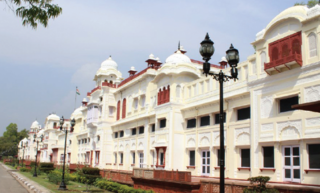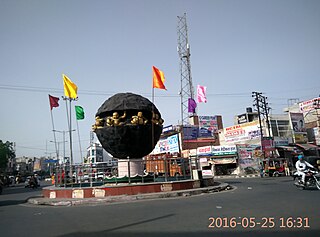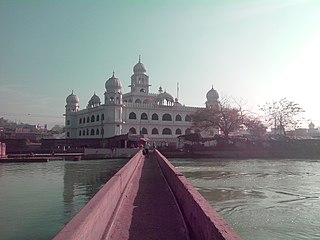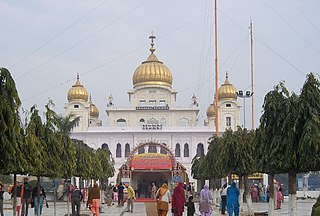
Patiala is a city in southeastern Punjab, northwestern India. It is the fourth largest city in the state and is the administrative capital of Patiala district. Patiala is located around the Qila Mubarak constructed by the Sidhu Jat Sikh chieftain Ala Singh, who founded the royal dynasty of Patiala State in 1763, and after whom the city is named.

Kaithal is a city and municipal council in the Kaithal district of the Indian state of Haryana. Kaithal was previously a part of Karnal district and later, Kurukshetra district until 1 November 1989, when it became the headquarters of the Kaithal. It shares a border with the Patiala district of state Punjab and the Kurukshetra, Jind and Karnal districts of Haryana. Kaithal district is situated in the North-West of the Haryana state. Its North-West boundaries, which include Guhla-Cheeka are attached to Punjab.

Anandpur Sahib, also referred simply as Anandpur, is a city in Rupnagar district (Ropar), on the edge of Shivalik Hills, in the Indian state of Punjab. Located near the Sutlej River, the city is one of the most sacred places in Sikhism, being the place where the last two Sikh Gurus, Guru Tegh Bahadur and Guru Gobind Singh, lived. It is also the place where Guru Gobind Singh founded the Khalsa Panth in 1699. The city is home to Takhat Sri Kesgarh Sahib, the third of the five Takhts in Sikhism.

Gurdwara Sis Ganj Sahib is one of the nine historical Gurdwaras in Delhi. It was first constructed in 1783 as a small shrine by Baghel Singh to commemorate the martyrdom site of the ninth Sikh Guru, Guru Tegh Bahadur and was probably expanded after Indian Rebellion of 1857 or after Partition of India. Before its construction the Mughal Kotwali was situated here. After the Indian Rebellion of 1857 the Mughal Kotwali was demolished by the British and the land was given to the Sikhs as the Maharaja of Patiala and other Sikh soldiers helped the British to defeat the Mughal soldiers by providing large numbers of ammunition and soldiers. Its current building was made by Rai Bahadur Narain Singh a contractor who build most of roads in Lutyens New Delhi construction under British Rule. Situated in Chandni Chowk in Old Delhi, it marks the site where the ninth Sikh Guru was beheaded on the orders of the Mughal emperor Aurangzeb on 11 November 1675. The Sikh regiment of the Indian army salute the Sis Ganj Gurudwara before saluting the president of India since 1979, the only instance of saluting twice in the Republic Day parade by a regiment of Indian army.
Morinda is a city with Municipal Council, near city of Rupnagar in Rupnagar District in the Indian state of Punjab. Morinda is an old town which is believed to trace its name from Mor Jats. It can be known as Moran and then Morinda.

Bassi Pathana is a historical city and a municipal council in Fatehgarh Sahib district in the state of Punjab, India. Bassi Pathana is the founder of the First Sewing Machine and its key parts in Asia, and this city created a historical invention in 1920 year.

Bhawanigarh, earlier known as Dhode, is a town and a municipal council (Class-3) in the Sangrur district in the state of Punjab, India. It is also the headquarters of Bhawanigarh tehsil, which was formed in December 2016. The town is also called Dhode, after the clan of its original founders. The town lies 19 kilometres east of Sangrur on the Patiala-Sangrur road whereas Patiala is 39 kilometres east of Bhawanigarh. The literacy rate is higher than other places of Sangrur. Bhawanigarh is divided into 15 wards. The Bhawanigarh block consists of 66 villages in the Sangrur district. New Gracious Education Hub is the leading educational institute of this town.
Samana is a town and a municipal council in Patiala district in the Indian state of Punjab.
The Khangura is a gotra of Jat community from the Punjab region in India.

Fatehgarh Sahib district is one of the twenty-three districts of the state of Punjab, India, with its headquarters in the town of Fatehgarh Sahib.
Kotla Suleman is a small village in Sirhind, Fatehgarh Sahib district, Punjab, India. It is located 2 kilometres to the south of the district headquarters, Fatehgarh Sahib, and 45 kilometres from the state capital, Chandigarh.
Sampli is a small village in the Bassi Pathana block of Fatehgarh Sahib district, in the Indian state of Punjab. This village is around 25 kilometres from Chandigarh-the capital of Punjab, 45 km from Patiala-academic city of Punjab, and about 75 km from Ludhiana-industrial city of Punjab.

Kiratpur, also known as Kiratpur Sahib, is a town in Rupnagar district of Punjab, India. The town is the location of the Gurdwara Patal Puri where many Sikhs take ashes of their deceased.

Gurdwara Fatehgarh Sahib is a Sikh gurdwara or place of worship in the city of Fatehgarh Sahib in the Indian state of Punjab. The gurdwara marks the 1710 conquest of the city by the Sikhs under the leadership of Banda Singh Bahadur. Sikhs captured the area and razed the fort built by Ferozshah Tughlaq to the ground.
Lehal, now Patiala, was the famous village because of the visit by Sikhs' ninth Guru but now this village is a part of Patiala city.
Baba Bakala is a historical town and tehsil in the Amritsar district in Punjab, India. It is known as the location of Gurdwara Baba Bakala Sahib.
Naulakha is a major village in Fatehgarh Sahib District, in the Indian state of Punjab.
Rupalheri is a village in Bassi Pathana Tehsil in the Fatehgarh Sahib District of Punjab, India. The village is equipped with all major facilities such as irrigation, water supply for homes and electricity. Along with this, it has two schools one is a Government senior secondary school and one Government elementary school. Students from nearby areas come to study here. There are three Gurudwaras, two temples, one mosque, and also a dera where people of all religions and castes came to pray and wish. The name of this dera is Dera Baba Rangi Ram Ji, Rupalheri. Every year in the month of June a fair is organized by the people of the village and nearby villages in Rupalheri. This fair includes various cultural games and recreational activities of Punjab such as music, wrestling, kabaddi, volleyball and other tournaments. The village also has S.H.C and a sub centre to cater to medical needs of nearby villages. The S.H.C is run by Zila Prashid Fatehgarh sahib. One Rural Medical Officer, one pharmacist, one class four employee are posted here. The sub centre is run by Punjab health department, one ANM and one multi purpose health worker are posted in the sub centre. this centre caters to five villages namely Rupalheri, Didiana, Kasumbari, Rallon, Gadhera. Besides public health, staff of sub centre also conducts regular immunization program on every Wednesday in different villages according to a given schedule. Also death and birth certificates are issued in the sub centre. Sub centre Rupalheri does not have its own building, at present it is running from the building of S.H.C Rupalheri. The other sub centre falling under S.H.C Rupalheri is sub centre Pamour. This centre caters to following villages Pamour, Sampla, Sampli, Kheribir, Shergarh bara, Kamali. The Rupalheri village is located 25.9 km from ISBT 43 Chandigarh
Hansali Sahib village is located in the tehsil of Fatehgarh Sahib in Fatehgarh Sahib district in the state of the Punjab, India. It is situated 11.5 km (7.1 mi) away from Fatehgarh Sahib, which is both district and sub-district headquarters for Hansali village. Governance of the village is by gram panchayat. The total geographical area of Hansali is 278 hectares. Fatehgarh Sahib is also the nearest town to Hansali.








